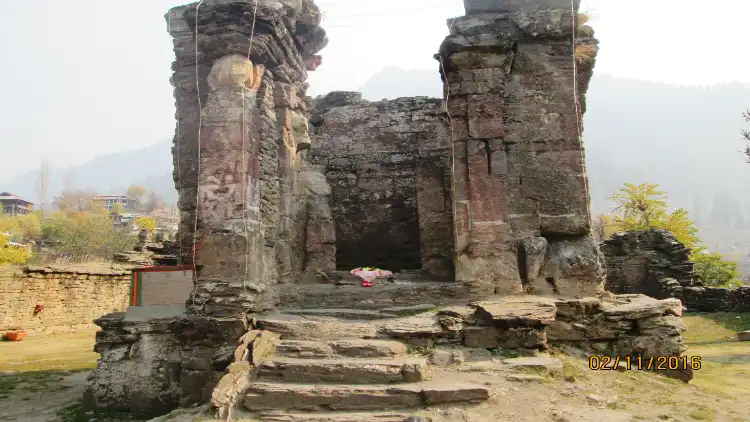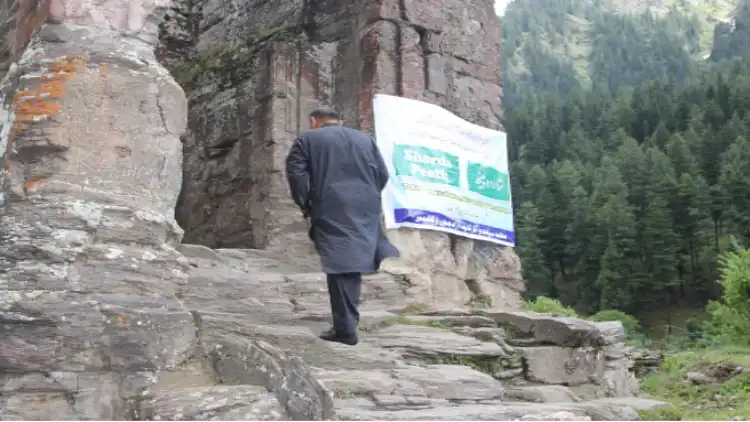
Aasha Khosa/New Delhi
When Prime Minister Narendra Modi laid the foundation stone of Ram Mandir at Ayodhya on August 5, not many Indians realised that a pinch of ancient history and heritage from Pakistan-occupied Kashmir had gone into its foundation.
Thanks to the efforts of Muslims of POK village Shardei where a 2,000-year-old temple of Goddess Saraswati lay in a ruinous state and that they are trying to preserve and seek attention to.
The temple of Sharda Mata, revered by Muslims and Hindus living across the fiery line of control (LOC), lay about 24 km from where Kishenganga river flows in north Kashmir and divides Neelam Valley into India and Pakistan-occupied lands.
According to Ravinder Pandita, a displaced Kashmiri pandit living in Delhi who campaigns for preservation of Sharda Peeth and opening it for pilgrims, villagers of Shardei handed over the soil from the temple to a Hong Kong based NRI couple who became the first Indian origin people to perform puja in river Kishenganga this year. They were not allowed to go to the temple despite valid visas.
The couple brought the soil to India and it went into the foundation of the temple at Ayodhya.
Sharda, the reigning deity of what was once Sharda desh and now Kashmir, stands as testimony to the glorious past of the region. The temple was once part of the world’s first university. A visiting Chinese Buddhist Monk Xuan Zang has written about the university complex in 632AD.
The roofless temple made of stones that are corroding making it look fragile, is without the statue of the deity and devotes yet it has not shaken the faith of locals – all Muslims - in Shardei Mai (Mother Sharda).

A Muslim vil;ages going inside the sanctum sanctorum of Sharda temple
Locals believe in legend of two sisters – Shardei Mai and Nardei Mai. For them the former, the Goddess of learning, was seated as a carved statue in the temple while the latter is incarnate in the hillock overlooking the shrine. The place is a confluence of three rivers – Kishenganga (called Neelam in POK), Madhumati and since vanished Saraswati where Hindus performed rituals for their ancestors.
In October, during navratri, the local Muslims led by Rais Mohammad, 72, offered flowers and vermillion at the shrine. They were guided by Sharda Mata followers from India who have been campaigning for opening it for pilgrims from India. They installed a picture of the Goddess sent by Pandita at the shrine. They sent him the soil from the premises as ‘prasad.’ The exchanges happened through human courtiers travelling across the two Kashmir in the since suspended bus service.
“All credit goes to the local Sharda committee in POK,” says Pandita. More importantly, he has managed to forge a common cause with POK Muslims in the era of total tension and breakdown of communication between the two countries.
Social media through internet came handy to Pandita to connect with Shardei people. It’s a hilly village of 50,000 people where every second shop is named after the Goddess. “When I connected with them, I was surprised to see how common cultural heritage can override the religious differences among people.” on his instructions, village of Shardei carry floral offerings for the Goddress on special occasions. Pandita has posted the video of this gesture on Twitter:
We will be conducting hawan as usual on this day in all ashrams of Swami Nand Lal ji"s lineage. Here's a video of our followers from across LoC,a few years ago,when on guru tritya they laid flowers on our behalf on Sharda peeth.Important day for kashmiri pandits- once sharda desh https://t.co/lNakrDKxZf pic.twitter.com/ncrodNvIe2
— Ravinder Pandita(Save Sharda) (@panditaAPMCC63) February 5, 2021
Notwithstanding the chill in the relations between India and Pakistan, Muslims and Hindus from across the POK are trying to preserve the shrine. “Supreme Court” of POK took note of Pandita’s letter about dilapidated condition of the Sharda temple and ordered its preservation. Again, his letter to DG Archaeology and Tourism, led the government to designate it as a monument of religious and historic importance. Two sign boards about its history as a temple and directions to the visitors to remove shoes before entering sanctum sanctorum have appeared in the compound.
“The outsiders had no clue to its actual identity and believed it to be a fort,” Pandita said.
Villages in Shardei are enthused by the efforts of Indians to bring their village back in cultural map of the world. They are seeking removal of a Pakistan Army Bunker erected in its compound in 2016. In an online interaction with Indians, villagers said they fear an Indian shell fired on Pakistani army bunker could hit the fragile temple. They support the efforts of the Indian counterparts of goading the two governments open the pilgrimage route to the shrine as they believe it would bring “business, prosperity and ilm (education) to the community.”
Following the cross LOC buzz on Sharda, the local administration has handed over 57 minority shrines, including a Gurudwara in Bhimbher, Poonch, across POK to the Archaeology and Tourism department for preservation. Recently Pakistan government has also allocated 1.73 crores for securing the temple with a compound wall and basic repairs.
In November on the annual pilgrimage day of the Sharda Mata, Pandita and his team reached the bank of river Kishenganga in Tangdhar while the Shardei villagers were waiting for them on the other side of the bank. The cross-river meeting was approved by the local Military commanders. The Indians performed Puja on the bank as Muslims from the other side watched in deep reverence to the Mai.
